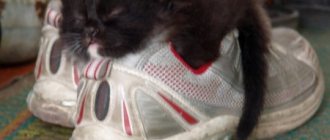1. What is calcivirosis?
Calicivirus infection or calicivirus (FCV) is a virus that causes upper respiratory tract infections and oral diseases in cats.
Both cats of exotic breeds and ordinary outbred “Murzik” cats can equally suffer from it. At the moment, at least 40 different types of this virus are known. They differ from each other in symptoms and severity of the disease. Of course, respiratory diseases in cats can be caused by various viruses and bacteria. But it is calicivirus infection that is considered one of the most common.
Symptoms of calcivirosis
Typical symptoms of an upper respiratory tract infection involve the nasopharynx. This may manifest itself in sneezing, nasal congestion, and conjunctivitis. There may also be discharge from the nose or eyes. Such discharge may be clear or purulent.
These are the most typical symptoms of calcivirosis in cats. But in some cases, cats with calicivirus infection may develop sores on the tongue, roof of the mouth, gums, lips, or nose. Cats that have mouth ulcers suffer from increased salivation. Atypical symptoms may also appear, such as anorexia, lethargy, fever, and enlarged lymph nodes. The cat may begin to squint.
In some cases, the only symptom of this infection may be sores in the cat's mouth or nose. But, as a rule, when infected, several symptoms appear at once. In some cases, a symptom may be sudden lameness in the animal. This symptom is more common in infected kittens.
One of the strains of calicivirus is called virulent systemic calicivirus disease
. It is known that the disease in this case is especially severe. At the initial stage of the disease, the animal's eyes, mouth and nose are affected. The infected cat then develops a high fever. The next symptom is swelling of the paws and muzzle, jaundice and diseases of the internal organs. This strain of calcivirus in cats is highly contagious, and the mortality rate in this case, according to statistics, reaches 67%. Fortunately, this particular strain of the disease is relatively uncommon.
Clinical signs:
Lesion on the tongue and in the oral cavity. Soreness, hypersalivation, problems with eating. Fever, lethargy, rhinitis (not expressed). With pneumonia, shortness of breath, cough, weakness, lameness.
Systemic calcivirosis:
- Systemic inflammatory response syndrome.
- Disseminated intravascular coagulation syndrome.
- Multiple organ failure.
External lesions:
Subcutaneous edema (extremities, head), ulcerations in the oral cavity, varying degrees of ulceration on the skin, pneumonia, necrosis of the liver, spleen, pancreas.
Chronic lymphocytic-plasmacytic stomatitis - carriage of calcivirus can be detected. The probable cause of stomatitis is the cat's immune reaction.
How can a cat become infected with calcivirus?
Calicivirus infection is actually very contagious. A healthy cat can become infected through the saliva, nasal and eye discharge of a sick animal. If a cat infected with calcivirus sneezes, the virus is sprayed into the air over a distance of several meters. There is also an assumption that infection can occur through the urine or feces of a sick animal. But this is not considered the main source of infection.
Cats susceptible to this infection can become infected through direct contact with an infected animal, through respiratory droplets, or through household items used by an infected animal.
The virus can survive for one week in the environment (and possibly longer in a cool, damp place). People who touch contaminated objects or come into contact with a sick animal can also become carriers of this virus.
Although cats can get calcivirus at any age, it most often affects kittens. But, at the same time, a strain of virulent systemic calicivirus disease
affects adults more seriously.
Caring for sick animals and prevention
In order for your pet to recover faster, you should first balance its diet, giving preference to easily digestible foods.
But since the sick animal does not show interest in food, you need to use liquid food, diluting pates, cereals, purees with milk or broth. Food should be administered using a syringe without a needle, often and in small portions.
It is also necessary to monitor the cleanliness of the bedding and equipment to eliminate the possibility of secondary infection.
Be sure to read:
Panleukopenia in adult cats and kittens: the first signs of the disease, how to treat and what to do
Preventive measures to eliminate the possibility of infection:
- vaccinate at two months of age followed by annual revaccination;
- limit your pet’s contact with street animals;
- put outer clothing and shoes in the closet immediately after coming home so that the animal does not come into contact with things;
- regularly change bedding and wash all pet equipment;
- Wash your hands thoroughly after touching someone else's cat.
How long does the disease last?
From infection to the appearance of the first symptoms, it usually takes from 2 to 6 days. In a mild form and with proper treatment, calcivirosis in cats lasts 14-21 days. This depends on the strain of infection. During the entire period of illness and 2-3 weeks after recovery, the sick animal is a carrier of the disease.
And in some cases, recovered animals can be potentially dangerous to other animals for several months or even a lifetime. Female carriers of the virus can infect kittens with calcivirus.
Diagnostics:
PCR diagnostics.
Material (washes from the conjunctiva, oropharynx, nose, skin, fragments of lung tissue) is not sensitive to viral mutations, may be sensitive after vaccination with a live vaccine.
A positive result is assessed with clinical signs, possible other causes (herpesvirus, bordetella, chlamydia), also secondary/combined infection.
Serology is not used in practice.
The animal does not excrete calcivirus, three negative results at intervals of a week.
Treatment
Most cats with uncomplicated infection can be treated at home. For purulent inflammation of the eyes, eye drops are usually prescribed. Broad-spectrum antibiotics are also used to prevent secondary infections. If the cat is limping, anti-inflammatory drugs are prescribed. In the presence of ulcers, immunomodulators and vitamins are also prescribed.
To make your cat's breathing easier, it is necessary to clear the airways. It is also recommended to remove discharge from the eyes and nose with a damp cotton pad.
Cats with a respiratory infection have a decreased sense of smell and, as a result, a decreased appetite. It is better to feed them wet food during this period. Sometimes it makes sense to give an appetite stimulant.
In case of severe dehydration, refusal to eat, and in particularly severe cases of illness, it is recommended to place the pet in an inpatient veterinary clinic for more intensive treatment, which will include IVs and other procedures.
Features of the disease in kittens
In small cats, the disease is more pronounced and has a rather severe course, fraught with dangerous consequences. Adults who have already received vaccinations and have no health problems can survive the infection without external manifestations of the disease.
- In a kitten, the disease begins with a high fever. There is an increase in body temperature up to 40 degrees. The condition lasts for 3 days, after which it gradually returns to normal.
- An increase in temperature is accompanied by discharge from the baby's eyes, nose and mouth. The cat's chest and chin are constantly wet.
- Abscesses containing clear fluid form on the palate, tongue, lips and tip of the nose.
- Often a kitten will experience diarrhea, alternating with constipation. There are cases when an animal vomits at the very beginning of the disease, just once.
- The cat coughs, it is difficult for her to swallow, and the act of swallowing may be impaired. In this case, you should feed the baby liquid food; if he refuses to eat, you can feed him with a syringe.
- The inflammatory process also affects the pet’s gums. They swell and turn red.
- Over time, all the alveoli are opened and ulcers form in their places, which are difficult to heal, causing pain and discomfort to the baby. Such open wounds are also dangerous from the point of view of the penetration of other infections into the body. Ulcers should be regularly disinfected with special means.
- Along with the appearance of lethargy and general weakness, a rotten smell begins to stink from the animal’s mouth.
At the first symptoms, you need to urgently consult a doctor and complete the entire course of treatment prescribed by him, otherwise a cat with reduced immunity may die if the disease recurs.
During the period of the baby's illness, it is necessary to give more fluids, support the body with vitamins, mineral supplements and stimulants to increase the body's resistance.
Disease prevention
Calcivirosis is a highly contagious disease. Cats can become infected with it in a variety of places: nurseries, shelters, at shows, on the street. Owners can bring the virus on clothes, shoes, or unwashed hands.
The likelihood of infection can be reduced by limiting your cat's contact with other animals. Owners should also wash their hands thoroughly upon returning home to avoid becoming a source of problems.
Immunocompromised cats can develop calcivirus after direct contact with another infected animal. Also, household items such as water and food bowls, trays, toys, bedding or cat houses can become a source of infection. Items that can become dangerous to a healthy animal must be treated. To do this, they need to be soaked in a bleach solution (1 to 32) for 10-15 minutes.
The best way to prevent calcivirus in cats is vaccination. Standard vaccines for cats also include vaccination against calicivirus infection. Vaccination will help reduce the severity of the disease and shorten the duration of the disease if the cat does get sick. Kittens require several shots of this vaccine between 6 and 16 weeks of age, and at least one more every year. After this, vaccination should be repeated on a regular basis every 1-3 years. It is especially important to get vaccinated if the cat is sent for foster care or to an exhibition. Or to any other place where the animal will come into contact with other pets. The veterinarian will advise the owners and help create an individual vaccination schedule, taking into account all the nuances.
How dangerous is calicivirus (calcevirus) infection for kittens?
The most dangerous pathology is for kittens, since their immune system is not fully formed and is not able to resist the introduction of the pathogen.
A lesion on the nose of the upper lip in an adult cat due to a calicivirus infection; the disease developed after the owners abandoned a young, apparently healthy kitten on the street
The danger of the virus is that kittens do not fully display clinical signs , and this makes diagnosis difficult. In most cases, they are similar to the symptoms of laryngitis, tracheitis and pneumonia, and a blood test shows anemia. Only diagnosing ulcerative glossitis helps to identify calicivirus.
Characteristic symptoms in kittens:
- apathy;
- lethargy;
- diarrhea;
- vomit;
- refusal to eat;
- photophobia.
Delayed treatment can cause death. If a pregnant cat is infected, the mortality rate for newborn kittens is 84-90% of all diagnosed cases.
Be sure to read:
Hemobartonellosis in cats: what is it, causes, symptoms and methods of treatment, prevention
Is there a risk of infection for other cats in the house?
A cat infected with calcivirus is considered contagious during the entire incubation period and for at least 3 weeks after the development of symptoms. A cat that is a carrier of a calcivirus infection can be potentially dangerous to other animals even throughout its life. Young, unvaccinated, or chronically ill cats are more susceptible to the disease. The disease may occur in them in a more severe form. In most cases, cats older than three years old, vaccinated, tolerate the disease relatively easily.
If a new pet arrives in the home, it must be isolated from the rest for 1-2 weeks to minimize the risk of transmitting calcivirus or other infectious diseases.











